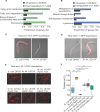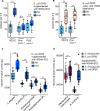Bacterial vitamin B12 production enhances nematode predatory behavior
- PMID: 32152389
- PMCID: PMC7242318
- DOI: 10.1038/s41396-020-0626-2
Bacterial vitamin B12 production enhances nematode predatory behavior
Erratum in
-
Correction: Bacterial vitamin B12 production enhances nematode predatory behavior.ISME J. 2020 Jul;14(7):1911. doi: 10.1038/s41396-020-0644-0. ISME J. 2020. PMID: 32246130 Free PMC article.
Abstract
Although the microbiota is known to affect host development, metabolism, and immunity, its impact on host behavior is only beginning to be understood. In order to better characterize behavior modulation by host-associated microorganisms, we investigated how bacteria modulate complex behaviors in the nematode model organism Pristionchus pacificus. This nematode is a predator that feeds on the larvae of other nematodes, including Caenorhabditis elegans. By growing P. pacificus on different bacteria and testing their ability to kill C. elegans, we reveal large differences in killing efficiencies, with a Novosphingobium species showing the strongest enhancement. This enhanced killing was not accompanied by an increase in feeding, which is a phenomenon known as surplus killing, whereby predators kill more prey than necessary for sustenance. Our RNA-seq data demonstrate widespread metabolic rewiring upon exposure to Novosphingobium, which facilitated screening of bacterial mutants with altered transcriptional responses. We identified bacterial production of vitamin B12 as an important cause of such enhanced predatory behavior. Although vitamin B12 is an essential cofactor for detoxification and metabolite biosynthesis, shown previously to accelerate development in C. elegans, supplementation with this enzyme cofactor amplified surplus killing in P. pacificus, whereas mutants in vitamin B12-dependent pathways reduced surplus killing. By demonstrating that production of vitamin B12 by host-associated microbiota can affect complex host behaviors, we reveal new connections between animal diet, microbiota, and nervous system.
Conflict of interest statement
The authors declare that they have no conflict of interest.
Figures




References
-
- Thaiss CA, Zmora N, Levy M, Elinav E. The microbiome and innate immunity. Nature. 2016;535:65–74. - PubMed

